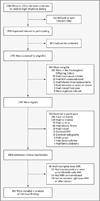Incidental meniscal findings on knee MRI in middle-aged and elderly persons
- PMID: 18784100
- PMCID: PMC2897006
- DOI: 10.1056/NEJMoa0800777
Incidental meniscal findings on knee MRI in middle-aged and elderly persons
Abstract
Background: Magnetic resonance imaging (MRI) of the knee is often performed in patients who have knee symptoms of unclear cause. When meniscal tears are found, it is commonly assumed that the symptoms are attributable to them. However, there is a paucity of data regarding the prevalence of meniscal damage in the general population and the association of meniscal tears with knee symptoms and with radiographic evidence of osteoarthritis.
Methods: We studied persons from Framingham, Massachusetts, who were drawn from census-tract data and random-digit telephone dialing. Subjects were 50 to 90 years of age and ambulatory; selection was not made on the basis of knee or other joint problems. We assessed the integrity of the menisci in the right knee on 1.5-tesla MRI scans obtained from 991 subjects (57% of whom were women). Symptoms involving the right knee were evaluated by questionnaire.
Results: The prevalence of a meniscal tear or of meniscal destruction in the right knee as detected on MRI ranged from 19% (95% confidence interval [CI], 15 to 24) among women 50 to 59 years of age to 56% (95% CI, 46 to 66) among men 70 to 90 years of age; prevalences were not materially lower when subjects who had had previous knee surgery were excluded. Among persons with radiographic evidence of osteoarthritis (Kellgren-Lawrence grade 2 or higher, on a scale of 0 to 4, with higher numbers indicating more definite signs of osteoarthritis), the prevalence of a meniscal tear was 63% among those with knee pain, aching, or stiffness on most days and 60% among those without these symptoms. The corresponding prevalences among persons without radiographic evidence of osteoarthritis were 32% and 23%. Sixty-one percent of the subjects who had meniscal tears in their knees had not had any pain, aching, or stiffness during the previous month.
Conclusions: Incidental meniscal findings on MRI of the knee are common in the general population and increase with increasing age.
2008 Massachusetts Medical Society
Figures


Comment in
-
Arthroscopic surgery for osteoarthritis of the knee?N Engl J Med. 2008 Sep 11;359(11):1169-70. doi: 10.1056/NEJMe0804450. N Engl J Med. 2008. PMID: 18784107 No abstract available.
-
Are meniscal tears common among adults >50 years?J Fam Pract. 2008 Dec;57(12):778-9. J Fam Pract. 2008. PMID: 19097336 No abstract available.
-
[MR imaging of the knees in patients over 50 years of age: incidental meniscal lesions].J Radiol. 2008 Dec;89(12):1897-9. doi: 10.1016/s0221-0363(08)74784-x. J Radiol. 2008. PMID: 19106846 French. No abstract available.
-
[Meniscus tears have a high prevalence in the middle-aged and elderly populations].Radiologe. 2010 Jul;50(7):585-7. doi: 10.1007/s00117-010-2036-3. Radiologe. 2010. PMID: 20571750 German. No abstract available.
-
Clinical significance of meniscal damage on knee MRI.Am Fam Physician. 2011 May 15;83(10):1160-2. Am Fam Physician. 2011. PMID: 21568248 No abstract available.
References
-
- Kurosawa H, Fukubayashi T, Nakajima H. Load-bearing mode of the knee joint: physical behavior of the knee joint with or without menisci. Clin Orthop Relat Res. 1980;149:283–290. - PubMed
-
- Shrive NG, O’Connor JJ, Goodfellow JW. Load-bearing in the knee joint. Clin Orthop Relat Res. 1978;131:279–287. - PubMed
-
- Walker PS, Erkman MJ. The role of the menisci in force transmission across the knee. Clin Orthop Relat Res. 1975;109:184–192. - PubMed
-
- Hall MJ, Lawrence L. Advance data from vital and health statistics. No. 300. Hyattsville, MD: National Center for Health Statistics; 1998. Aug 12, Ambulatory surgery in the United States, 1996. (DHHS publication no. (PHS) 98-1250.) - PubMed
-
- Englund M, Lohmander LS. Risk factors for symptomatic knee osteoarthritis fifteen to twenty-two years after meniscectomy. Arthritis Rheum. 2004;50:2811–2819. - PubMed
Publication types
MeSH terms
Grants and funding
LinkOut - more resources
Full Text Sources
Other Literature Sources
Medical
